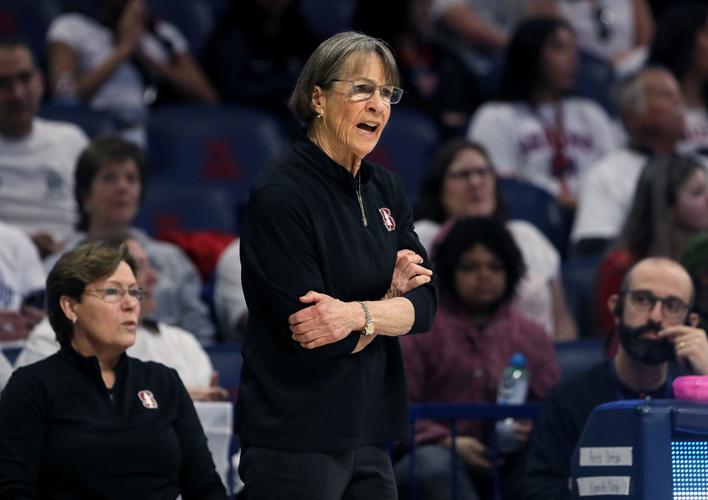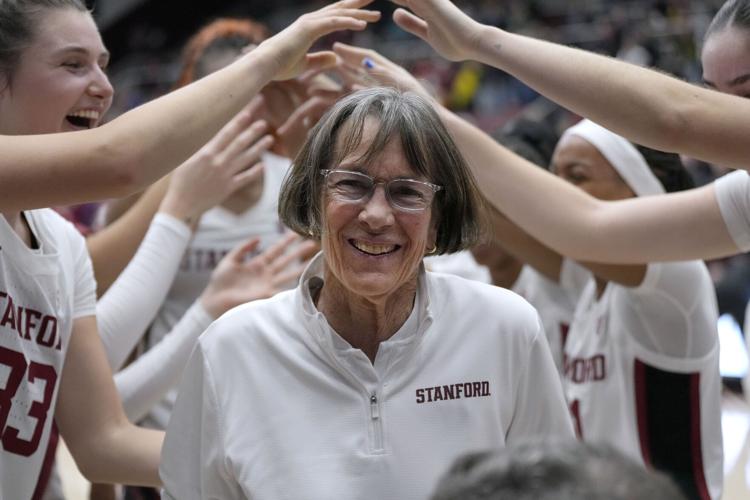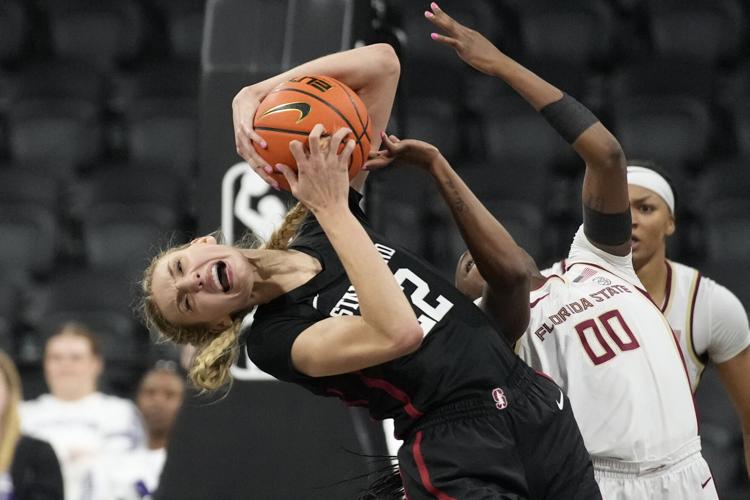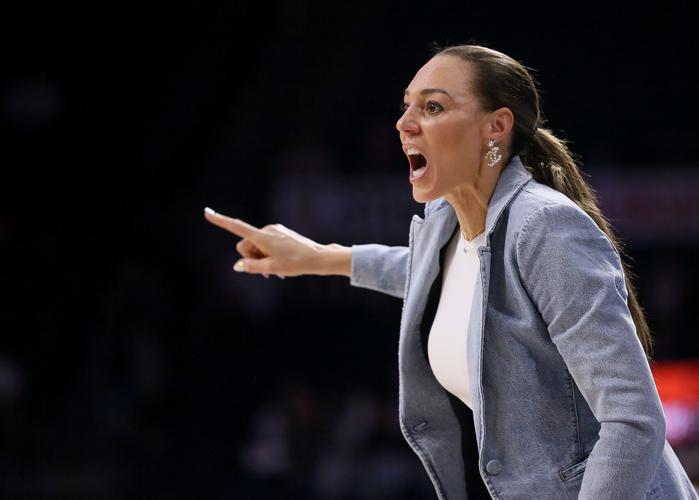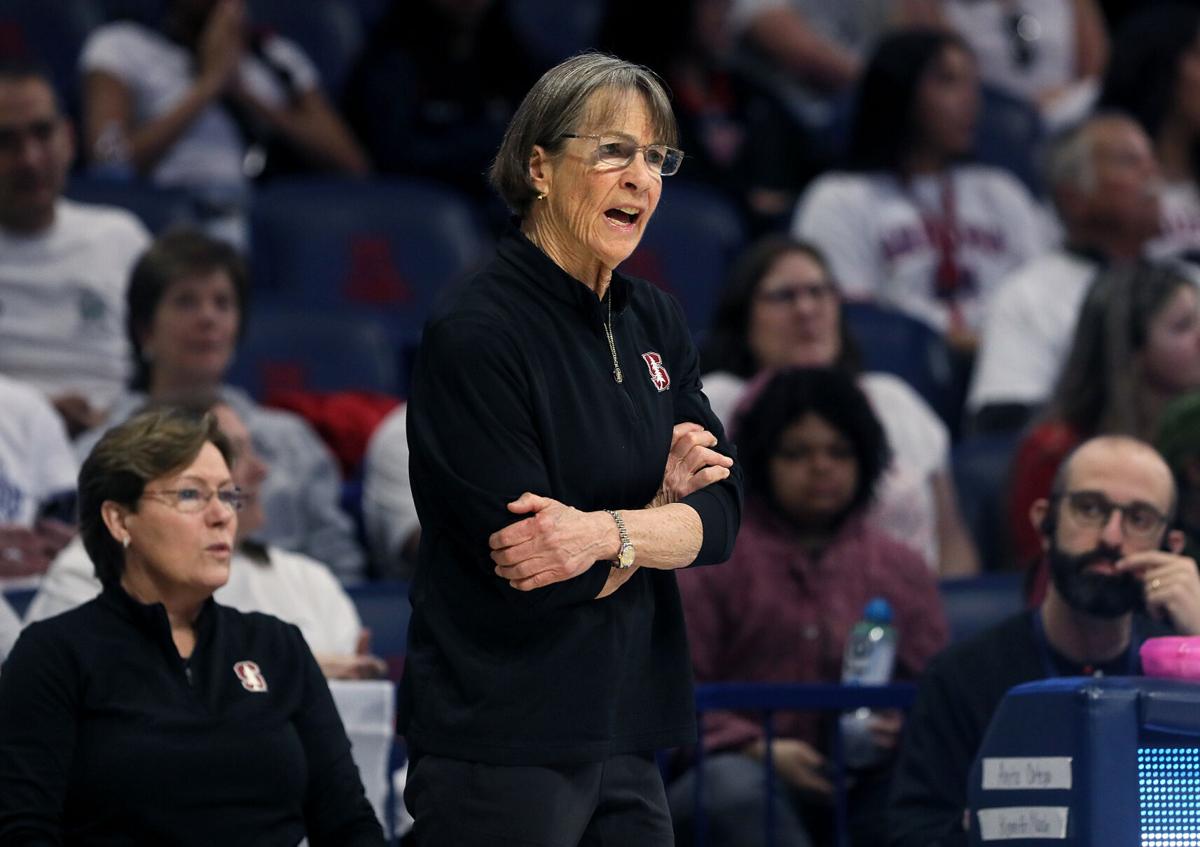Women’s college basketball has never been more popular.
Last week’s LSU-South Carolina matchup on ESPN was the most-watched sports program of the night, averaging 1.56 million viewers and topping the NBA on TNT (1.38M). The Iowa-Ohio State game four days earlier on NBC, featuring Hawkeyes megastar Caitlin Clark, drew the largest audience (1.86M) for a regular-season women’s game since 2010. Last year’s NCAA title game between Iowa and LSU averaged 9.9 million viewers on ABC and ESPN2 — more than doubling the previous year’s finale.
College athletics, as a whole, have never been more fraught.
Athletic departments are struggling to balance their budgets amid soaring costs. The NCAA is facing multiple lawsuits — including one seeking $1.3 billion in damages. NIL (Name, Image and Likeness) has transformed into PFP (Pay for Play). Powerful, Wizard of Oz-like TV executives have created two football super leagues, collateral damage be damned.

Stanford coach Tara VanDerveer smiles as players celebrate her 1,202nd victory as a college coach, against Oregon on Friday, Jan. 19, in Stanford, Calif. VanDerveer tied former Duke men's basketball coach Mike Krzyzewski for the most wins with that victory, and is now up to 1,205.
Where does Stanford women’s basketball — one of the iconic brands in the sport — fit into this picture?
And why would Tara VanDerveer — the all-time winningest college basketball coach, men or women — want anything to do with it?
If you caught even a few minutes of the Cardinal’s visit to McKale Center on Sunday, you could see that Stanford is still Stanford. The Cardinal dominated the shorthanded Wildcats. Stanford could have scored well over 100 points if VanDerveer had kept her starters in the game. As it was, the Cardinal cruised to a 96-64 victory. Arizona never had allowed that many points in a game in Adia Barnes’ seven-plus seasons.
The question is whether Stanford can continue to be Stanford.
Last spring, three players — including 6-7 center Lauren Betts, the No. 1 prospect in the class of 2022 — entered the transfer portal and left The Farm. Those moves sent shockwaves through the women’s college basketball community because, well, that just didn’t happen to Stanford.
“We're not portal people,” VanDerveer said bluntly after Sunday’s game.
That might sound snooty, but VanDerveer is just spouting facts. Because of its high academic standards, Stanford isn’t a player in the portal game. It will always lose more than it adds — if it adds anybody at all.
Some might see that as a disadvantage; VanDerveer doesn’t. She believes Stanford has plenty to offer in the NIL space to its student-athletes — plus, of course, a first-class education and the chance to live in Northern California for 4-5 years. That’s a pretty good deal.
VanDerveer decried the impatience that the portal and unlimited transferring have wrought. On the flip side, she cited the example of junior forward Kiki Iriafen.
Like so many Cardinal players, Iriafen was a four-star, top-20 prospect when she arrived on campus. She came off the bench as a freshman, averaging 6.5 minutes and 4.2 points. Her role grew as a sophomore (12.1 minutes, 6.7 points). Now she’s thriving as a full-time starter (25.7, 19.0).

Stanford coach Tara VanDerveer is congratulated by forward Kiki Iriafen after her record-setting victory on Jan. 21.
“Sometimes when you work really hard for something, you appreciate it more,” VanDerveer said. “I really respect a player like Kiki who battled through adversity. Now she's a better player because of it.”
The recruit-and-develop formula is still working for the 19-2 Cardinal. They’re No. 4 in the latest AP poll and one of only two Pac-12 teams that are more than a game above .500 on the road.
How long that lasts remains to be seen — especially in light of what’s coming.
The Pac-12 Conference’s collapse last summer left Stanford and Cal in limbo. Desperate for financial stability and competitive viability, they joined the ACC — even though the “A” stands for “Atlantic.”
VanDerveer — who’s been coaching at Stanford since 1985, when Barnes was 8 years old — is still mourning the Pac-12’s passing.
“I'm really sad about it,” she said. “We love coming and playing (at) Arizona, Arizona State. I hope we can play them without it being a conference game — or maybe someday some smart people will get together and we'll be back in the conference together.
“What a great conference we've been a part of. It's heartbreaking to me, to be honest with you.”
I spoke to VanDerveer for about seven minutes after her postgame scrum. She practically experienced all seven stages of grief during that time.
“How did we ever get in the place we're in right now? It makes no sense,” VanDerveer said. “We have a great league, and it was destroyed by, I think, greed. Obviously, we know money's important to athletics because it's so expensive. But it seems like there should have been better vision and better leadership to not to get where we are.”
VanDerveer is in the acceptance and hope phase now. What choice does she have?
Despite her stature as a coaching titan, it’s not as if she had any real say-so in Stanford’s athletic future; football and finances dictate those decisions.
Despite the logistical challenges, joining the ACC beat the alternative in VanDerveer’s view. Going independent was never a real option, she said. Playing in the West Coast Conference wasn’t appealing.

Stanford forward Cameron Brink (22) and Florida State guard Ta'Niya Latson (00) battle for the ball during the second half of their game Nov. 24, 2023, in Henderson, Nev. Cardinal-Seminoles matchups soon will become commonplace with Stanford joining the ACC.
“It's not ideal,” VanDerveer said of Stanford landing in the ACC. “But we're excited about the great competition.
“Every rose has a thorn, and the thorn is travel.”
When the Pac-12 was shopping its media rights last year, ASU president Michael Crow described Apple’s offering as a “technological, 23rd-century ‘Star Trek’ thing.” It turns out that what these programs really need is a transporter.
VanDerveer said that the ACC will use a travel-partner system. Stanford and Cal will each get a two-for-one when they go east. Stanford will strive to schedule its nonconference games on the West Coast — which could mean, for better or worse, that the Cardinal will be appearing at McKale again in the near future.
“I’m confident it’s not my last time playing against Stanford here,” Barnes said Sunday.
It’s pretty likely that Barnes and VanDerveer already have had those conversations. Like so many in their field, Barnes considers VanDerveer a mentor.

Arizona coach Adia Barnes shouts out to her team in the second half of the Wildcats' game against Stanford at McKale Center on Sunday. Barnes considers Stanford's Tara VanDerveer one of her mentors.
When Barnes first became Arizona’s head coach, VanDerveer would “give me advice and wanted us to be good and wanted me to be successful as a woman coaching,” Barnes said.
“It was never about Stanford or their success. It was always about women’s basketball. ... I really respected that.”
That story tells you a lot about VanDerveer: She didn’t feel threatened by an up-and-comer. Rather, she saw Barnes elevating the UA program as a good thing for the league and the sport.
Amid all the doom and gloom surrounding the future of college athletics, it’s important to remember what the world was like when pioneers such as VanDerveer were coming up. In an interview with the San Jose Mercury News several years ago, VanDerveer was asked about her high school basketball career.
“When I was in high school,” said VanDerveer, who grew up on the East Coast in the 1950s and ’60s, “there were no sports for girls.”
She eventually played at a prep school in Buffalo, New York, and for three seasons at Indiana. It wasn’t like it is now. Not even close.
“I imagined it. But ... it was more of a dream,” VanDerveer, 70, said. “I would shoot around as a young girl by myself and think of big arenas and fans like this.
“I'm jealous of our players. I had horrible timing as a player.
“But I have good timing as a coach. I'm really excited about the opportunity I have, and I’m enjoying every minute.”
As she should.
Arizona women's basketball coach Adia Barnes speaks on her team's performance after the Wildcats fell at home to Stanford 96-64 at McKale Center on Jan. 28, 2024. (Video courtesy Arizona Athletics)


